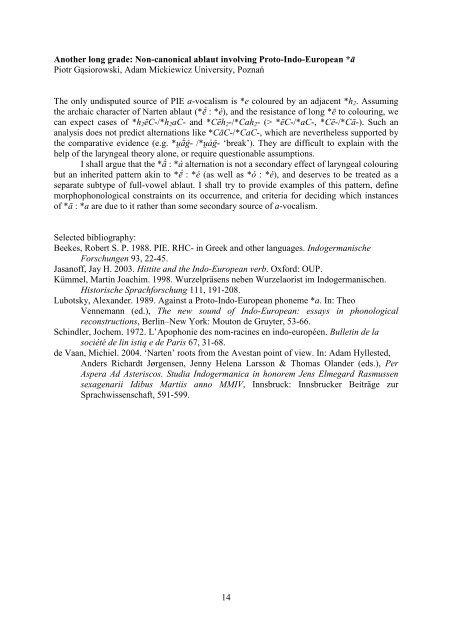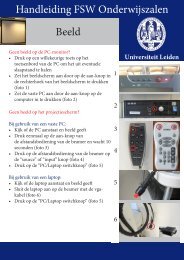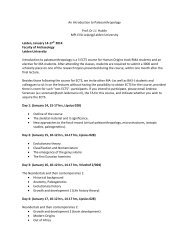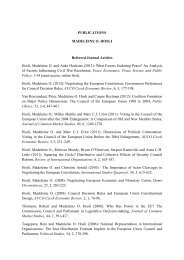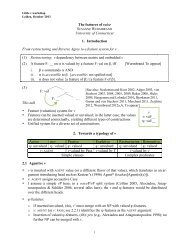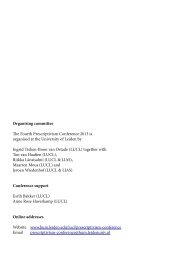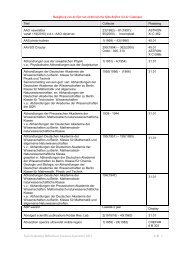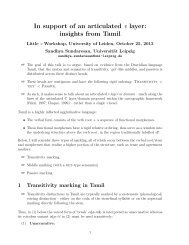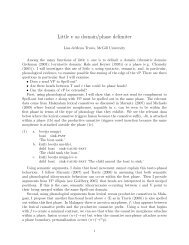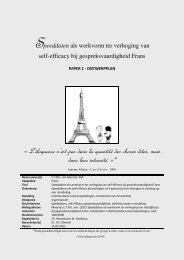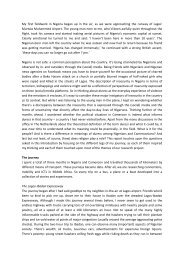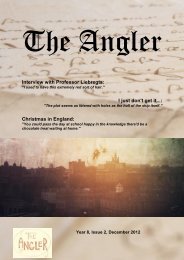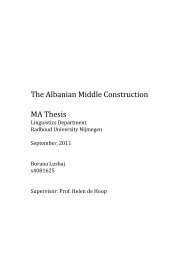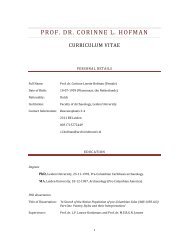Programme
Programme
Programme
Create successful ePaper yourself
Turn your PDF publications into a flip-book with our unique Google optimized e-Paper software.
Another long grade: Non-canonical ablaut involving Proto-Indo-European *ā<br />
Piotr Gąsiorowski, Adam Mickiewicz University, Poznań<br />
The only undisputed source of PIE a-vocalism is *e coloured by an adjacent *h 2 . Assuming<br />
the archaic character of Narten ablaut (*ḗ : *é), and the resistance of long *ē to colouring, we<br />
can expect cases of *h 2 ēC-/*h 2 aC- and *Cēh 2 -/*Cah 2 - (> *ēC-/*aC-, *Cē-/*Cā-). Such an<br />
analysis does not predict alternations like *CāC-/*CaC-, which are nevertheless supported by<br />
the comparative evidence (e.g. *u̯ ā́ ĝ- /*u̯ áĝ- ‘break’). They are difficult to explain with the<br />
help of the laryngeal theory alone, or require questionable assumptions.<br />
I shall argue that the *ā́ : *á alternation is not a secondary effect of laryngeal colouring<br />
but an inherited pattern akin to *ḗ : *é (as well as *ó : *é), and deserves to be treated as a<br />
separate subtype of full-vowel ablaut. I shall try to provide examples of this pattern, define<br />
morphophonological constraints on its occurrence, and criteria for deciding which instances<br />
of *ā : *a are due to it rather than some secondary source of a-vocalism.<br />
Selected bibliography:<br />
Beekes, Robert S. P. 1988. PIE. RHC- in Greek and other languages. Indogermanische<br />
Forschungen 93, 22-45.<br />
Jasanoff, Jay H. 2003. Hittite and the Indo-European verb. Oxford: OUP.<br />
Kümmel, Martin Joachim. 1998. Wurzelpräsens neben Wurzelaorist im Indogermanischen.<br />
Historische Sprachforschung 111, 191-208.<br />
Lubotsky, Alexander. 1989. Against a Proto-Indo-European phoneme *a. In: Theo<br />
Vennemann (ed.), The new sound of Indo-European: essays in phonological<br />
reconstructions, Berlin–New York: Mouton de Gruyter, 53-66.<br />
Schindler, Jochem. 1972. L’Apophonie des nom-racines en indo-européen. Bulletin de la<br />
société de lin istiq e de Paris 67, 31-68.<br />
de Vaan, Michiel. 2004. ‘Narten’ roots from the Avestan point of view. In: Adam Hyllested,<br />
Anders Richardt Jørgensen, Jenny Helena Larsson & Thomas Olander (eds.), Per<br />
Aspera Ad Asteriscos. Studia Indogermanica in honorem Jens Elmegard Rasmussen<br />
sexagenarii Idibus Martiis anno MMIV, Innsbruck: Innsbrucker Beiträge zur<br />
Sprachwissenschaft, 591-599.<br />
14


